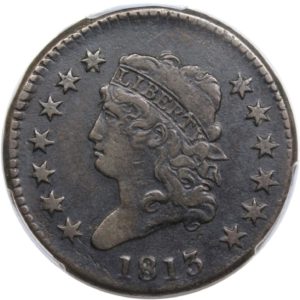Classic Head Cents (1808-1814)
The design of the Classic Head Cents appeared in 1808, the 5th redesign in just 15 years of production. The design known as the Classic Head Cent was based on the design of previous large cents but the resemblance is almost negligible.
The same design was introduced for the half cent in 1809 and later for the silver and gold denominations. Despite carrying similar features, however, each coin had an overall distinctive look.
each coin had an overall distinctive look.
It was John Reich who designed the Classic Head Cents, with the head of Liberty facing left for the first time. She had curly hair that was held together with a headband inscribed with LIBERTY. The headband is said to have originated in ancient Greece.
It was also on the Classic Head Cents that stars were featured on the obverse and placed adjacent to Liberty’s portrait. The 13 stars represented the original states, with 7 arranged to the left and 6 to the right.
The reverse of the Classic Head Cents, on the other hand, had the same basic design previously used in other coins but with a different appearance. The denomination ONE CENT was placed on the center and encircled by an olive wreath that is also encircled by UNITED STATES OF AMERICA.
The change from 1/100 to ONE CENT indicated that more Americans learned to read and write by the time the coin came out.
John Reich’s design was heavily criticized and was short-lived. By 1834, another design was developed by US Second Chief Engraver William Kneass. Reich’s work, however, would be used on other denominations for several decades.
The half cents of the Classic Head Cents were minted from 1809 to 1836, while the large cents were minted from 1808 to 1814.
There were just over 1 million pieces of half cents struck in 1808. The following year, there was a shortage of cents because the Mint run out of planchets. In 1809, official records state that there were only 222,867 cents struck. Research showed, however, that nearly 50,000 cents minted in June of that year may have been struck using dies left over from 1808.
It was in 1810 when production returned to normal, resulting in the highest output for the series at 1,458,500.
The years following this saw a series of highs and lows in production. In 1814, the series of Classic Head Cents came to an end.
For all 7 dates, the combined total mintage is just 4,757,722, all of which were produced by the Philadelphia Mint. The series had no great rarities and no common dates, with 1809 as the scarcest date.
Among the many collectible coins, the Classic Head Cents are widely collected according to dates, with overdates and other varieties included in the set of dedicated hobbyists.
1804 coins that are commonly found are pursued by type collectors. The coins have the occasional touches of mint red and generally sharper strikes. Although the Mint did not make any proofs, a tiny hoard of prooflike and partially mint-red examples of 1810 was discovered in the 1930s.
Classic Head Scents are hard to find in every collectible grade and just as scarce in mint condition.
